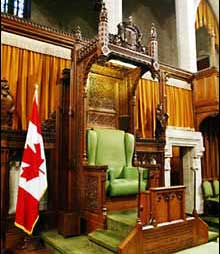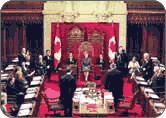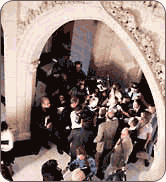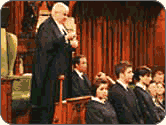
|
|

|
|

|
||||||
 |
OPENING THE THIRTY-EIGHTH PARLIAMENT HOLDING THE GOVERNMENT TO ACCOUNT Chamber Activities
Opening the
Thirty-eighth Parliament
|

|
PHOTO: © HOUSE OF
COMMONS |
Selecting
Presiding Officers
In addition to the Speaker, three other officers must
be selected by Members from among their own ranks to
preside over proceedings of the House of Commons. These
presiding officers assist the Speaker in ensuring that
proceedings in the Chamber conform to the rules and
traditions of the House at all times.
In keeping with new rules adopted in the Thirty-eighth Parliament, the Speaker proposed candidates after consulting with the leaders of recognized political parties in the House of Commons. With a unanimous vote of confirmation, the following presiding officers were elected: Chuck Strahl, Deputy Speaker and Chair of Committees of the Whole; Marcel Proulx, Deputy Chair of Committees of the Whole; and the Honourable Jean Augustine, Assistant Deputy Chair of Committees of the Whole.


|
|
The Speaker's Chair is the focal point of the House of Commons Chamber. Situated on a dais at the north end of the Chamber, the chair provides the Speaker with a clear view of government and opposition benches, as well as the public galleries above the Chamber floor. Constructed in 1921 and presented to the House by members of the Empire Parliamentary Association, the Speaker's Chair includes an overhead canopy that features the Royal Arms sculpted from a piece of oak taken from the roof of Great Britain's Westminster Hall built in 1397. The Speaker's Chair also displays carvings of two symbols of authority: a scepter surmounted by a dove, and a mace on a background of intertwined cords and oak leaves with acorns. |
|
![]()
The Speaker holds the position of highest authority in the House of Commons. Responsible for maintaining order and decorum in the Chamber, the Speaker also serves as spokesperson and representative of the House of Commons in its relations with the Senate, the Crown and other bodies. In addition, the Speaker oversees the administration of the House of Commons and presides over the Board of Internal Economy, which is the governing body of the House of Commons.
Making
Laws
Once the essential first business of the House of
Commons is concluded, Members can undertake their work
in the Chamber-making and amending laws, holding the
government to account, and presenting reports and other
formal documents to the House.
All federal laws in Canada begin as bills: proposals to Parliament for consideration and amendment. For a bill to become law, it must be adopted by both the Senate and the House of Commons in identical form and then receive Royal Assent (the final step in the legislative process). Government bills are introduced by the Minister responsible for the particular issue at hand; Private Members' bills are introduced by Members who are neither a Minister nor a parliamentary secretary.
From April 1, 2004 to March 31, 2005, 84 government bills and 628 Private Members' bills were introduced in the House of Commons. Bills may pass quickly or may take long periods of time to become law, depending on their urgency, complexity and the degree of consensus among Members with respect to the matter at hand.
Legislation introduced by the government covered a wide spectrum of national policy matters, including bills to amend the Criminal Code, to revise electoral boundaries, to establish new relationships with First Nations and to reform the transportation system. Private Members' bills extended across an equally broad range of issues, including: the proposed elimination of conditional sentencing for violent offenders; the introduction of health warning labels regarding alcohol consumption; the prevention of psychological harassment in the workplace; and amendments to the Employment Insurance Act.
Nearly 400 motions were drafted to amend bills at either the committee or report stage. At the time of this report's preparation, Members were in the midst of debating amendments to the Competition Act, the Food and Drugs Act, the Telecommunications Act, the Grain Act, and numerous other acts. Members were also considering new measures to prevent the introduction and spread of communicable diseases, to govern not-for-profit corporations, to establish the Canada Border Services Agency, to implement provisions contained in budgets tabled in Parliament, and to alter certain aspects of legal capacity for marriage for civil purposes.

PHOTO: MCPL CINDY MOLYNEAUX
![]()
![]()
Holding the
Government to Account
A crucial function of the House of Commons is to hold
the government to account. While in the Chamber,
Members of Parliament fulfill this role in a number of
ways, including raising questions during
Question Period, submitting written questions, and
choosing topics for debate on allotted days.
Oral questions are posed during the 45 minutes reserved each sitting day for Question Period. Typically, Members of opposition parties put questions to ministers or parliamentary secretaries responding on behalf of ministers; but Members from the governing party who are not in Cabinet may also ask questions, and questions may also be put to committee chairs. Questions soliciting detailed, lengthy or technical information from the government are normally submitted in written form and replies to written questions are tabled in the House of Commons once they have been prepared. During the 2004-2005 fiscal year, 3,731 oral questions were posed and 144 written questions were submitted.
Allotted days -also known as opposition or supply days- are reserved for debate on topics chosen by the opposition parties. The usual 21 allotted days per calendar year are divided among the opposition parties according to their representation in the House of Commons. In 2004-2005, issues discussed on allotted days included offshore oil and gas revenues; a ban on trans fats; maintenance of land, air and sea combat capability; federal assistance to ranchers; and combating organized criminal activity.
Tabling
Documents
When a document is "tabled", it is presented formally
before the House of Commons and becomes part of the
official public record. Tabling may be required by law,
by the Standing Orders, or by a motion adopted by the
House. Documents that must be tabled include the annual
reports of departments and agencies,
Order-in-Council appointments (which are made by the
Governor General on the advice of Cabinet), and
government responses to committee reports and
petitions. Ministers are entitled to table any report
or paper dealing with matters related to the
administrative responsibilities of the government.
During the 2004-2005 fiscal year, 1,393 documents were tabled in the House of Commons, including the budgets-or "Main Estimates" as they are called-for all government spending.

PHOTO: © HOUSE OF COMMONS
Managing Chamber
Activities
The proceedings of the House of Commons are regulated
chiefly by the Standing Orders and by the practices and
traditions that have developed in Canada or been
adapted from the British Parliament. These rules and
practices evolve in two distinct ways: through the
adoption of rule changes made by a decision of the
House, or through the Speaker's interpretation of rules
and traditions in what are called
Speaker's decisions.
Speaker's decisions form a fundamental part of parliamentary procedure. In the period of this report, the Speaker delivered 19 rulings on a range of topics, from specific questions on such issues as ballistic missile defence and public health to requests for emergency debates over the Ukrainian political situation and Canada's livestock industry.

PHOTO: © HOUSE OF COMMONS